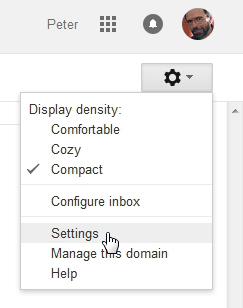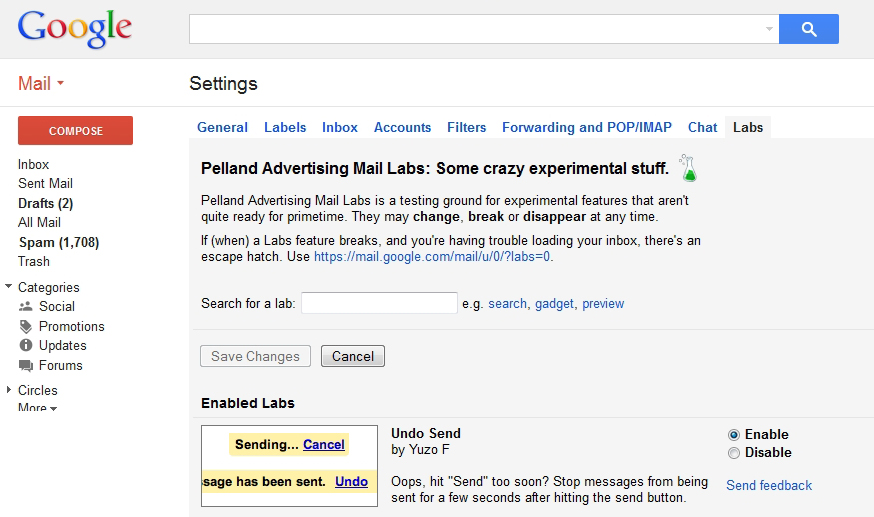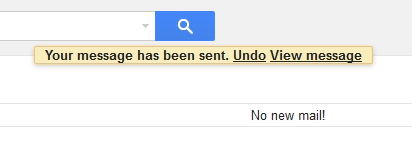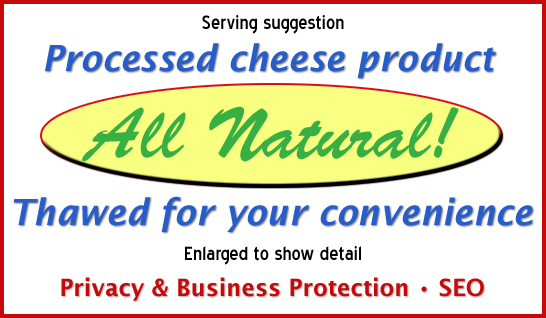Wait! No! I Did Not Want to Send That!
June 24th, 2015
Have you ever sent an e-mail, then moments later wished you had a way of “unsending” it? Of course you have. We all have done this. We accidentally hit the “send” button, realize that we sent the message to the wrong person, or think that maybe we should give more thought to the message before actually sending it. It is one thing to send an e-mail like that to your Aunt Clara, but it is something else entirely to send that e-mail to one of your business correspondents.
Many people use Gmail to host their e-mail accounts, and many of those people send and receive their messages using the Gmail Web interface. If you are one of those people, you are now in luck in those instances of “sender’s remorse”.
Most people are not aware that Gmail includes a setting called “Labs”, which they describe as “some crazy experimental stuff” and “a testing ground for experimental features that aren’t quite ready for primetime.” One of these has been the “Undo Send” feature, a setting that has been hidden away since 2009 but is now ready to be broadly introduced as a mainstream Gmail feature, although you must manually install it. The feature is also a component of Gmail’s new “Inbox” app. Want to give it a try? Follow these steps.

Click on the down arrow next to the little gear in the Gmail interface to enter the settings. In the settings, choose the “Labs” tab, all the way on the right. You will then see a list of available labs, along with any labs that you may have already enabled. They will be listed alphabetically. Scroll down to “Undo Send”. Click the “Enable” radio button, then scroll down to the bottom of the page to “Save Changes”.

The Undo Send feature will then appear under the “General” settings tab, where you can set the cancellation period for anything from 5 to 30 seconds. (I suggest the 30 second option.) Basically, what this is doing is caching your message for a brief period of time before it is actually sent, giving you an opportunity to have second thoughts and cancel the sending of your e-mail.

Now, when you actually send an e-mail, after you hit “Send”, you will see an “Undo” link. Click on that, and the message will be cancelled and sent to the Gmail drafts folder.

You can then recompose yourself, recompose your message, and continue through the rest of the day without further panic.
This post was written by Peter Pelland
Tags: Gmail Inbox, Gmail Labs, Gmail settings, Undo Send
Posted in Google Resources |
Successful Marketing: Long-Term Objectives
June 15th, 2015
For any business, the home run measure of success for any marketing tool is the generation of an immediate sale. Sometimes that means the purchase of an item or the ordering of a service. In the hospitality industry, that immediate sale translates into a reservation for a stay. Those are the home runs, but the game is won in multiple innings, the cumulative effect of singles, doubles, runs batted in, and strike-outs.
What are those lesser, long-term measures of marketing success that, taken cumulatively, can often exceed the impact of the immediate sales? Allow me to outline a few of them.
Engagement
Engagement is the encouragement of long-term customer loyalty. It can be argued that short-term sales can sometimes be in conflict with the interests of long-term customer engagement. For example, coercing an immediate sale through the use of deep discounting will almost never lead to long-term customer loyalty. Rather, it likely leads to either one-time sales or the development of customers who will only purchase again when you offer another deep discount. Customer engagement can be built through expertise in your field, the presentation of useful information, the delivery of frequently updated content, and interaction with your customer base.
Brand Awareness
Brand awareness is essentially the development of a company’s name recognition and reputation. It is far easier to accomplish for an established name brand with hundreds or thousands of locations to build brand awareness than it is for an individual start-up business. Think in terms of McDonald’s versus Charlie’s Burger Joint. Brand awareness goes beyond simple name recognition. It requires that consumers not only recognize your business name but also that they will be more likely to recall the name in the future and correctly associate it with the special attributes of your business. For example, you might be one of a dozen and a half campgrounds in the area, but you want to be remembered as THE place to camp in Myrtle Beach, South Carolina. I have routinely documented instances where a campground that changed its name over 10 years ago continues to get business from people who recall the old business name (and are directed to the park’s website via the old URL, which we maintain.)
Customer Evangelism
Customer evangelism is good old word-of-mouth advertising on steroids. The term has obvious biblical origins, where surrogates are engaged to spread the good news, in this case regarding your business. Evangelists do not take their roles lightly, and they do not agree to take on their responsibilities without first being truly converted themselves. They have to really believe in a product or service before they will agree to act as voluntary advocates on your behalf. Their evangelism can take many forms, from direct referrals to social media posts to loyalty programs to affinity groups. A park’s seasonal campers might be one such affinity group. The bottom line is that any of these are unpaid customers who are perhaps your company’s best possible spokespersons, primarily because they are spreading the word based upon their authentic personal beliefs.
Customer Loyalty
Sharing some characteristics with both engagement and evangelism, customer loyalty is the result of an ongoing reassurance that your business is meeting the needs of its existing customers. A new website, an eye-catching billboard, or a well-crafted video or TV commercial can serve to not only generate new business but to reassure your existing customers that they made the right decision in choosing your business. Make them proud of their decision and help to give them a sense of belonging and involvement. This, in turn, is an added step toward taking loyalty to the next step … evangelism.
Lead Generation
Sometimes potential customers are not ready to make an immediate purchase or buying decision. For example, it is not easy to persuade people to buy snowmobiles in the summer. Beyond the attempt at timing your marketing efforts for when they will be the most effective, lead generation is a means of qualifying a broad list of prospective customers into a narrower list that is more likely to make a future purchase. Do you ask them to become involved? Try to encourage people to subscribe to your newsletter, join your e-mail list, or sign up for special offers and incentives. In any case, a potential customer who has taken the initiative of any such “next step” is that much closer to becoming an actual customer.
In summary, do not be discouraged if every marketing effort does not translate into immediately measurable sales. Marketing is a cumulative, long-term effort, not some sort of “all your eggs in one basket”, “get rich quick” scheme. Present your business in a professional, consistent manner, and it will eventually reap the rewards of a bountiful harvest.
This post was written by Peter Pelland
Tags: brand awareness, customer engagement, customer evangelism, customer loyalty, lead generation, long-term marketing, marketing objectives
Posted in Marketing Strategies |
Truth in Packaging
June 10th, 2015
When it comes to processed foods, probably the most deceptive phrases are:
- Serving suggestion.
- Enlarged to show detail.
- All natural.
The serving suggestion lets you know that the strawberries and blueberries in that bowl of cereal are not included in the box, the image that is enlarged to show detail helps you to really see what that cracker or potato chip looks like, and the words “all natural” have no definition whatsoever and can include just about every chemical compound found on the planet. The first two phrases are usually shown in very fine print, whereas the last phrase is generally promoted in large text with an eye-catching graphic.

It is unfortunate that parts of the business world have adopted language that essentially applies this same sort of lipstick to their pigs. A used car becomes “previously owned”, previously frozen fish in the supermarket becomes “thawed for your convenience”, products made in China might be “assembled and packaged in the USA”, and most people know that a “processed cheese product” is anything but real cheese. In particular, some of this deception has become commonplace in the Internet industry.
Serving Suggestion
If you have ever registered a domain name with a company like GoDaddy, you will encounter their version of the “serving suggestion”. I just went to GoDaddy to try to register a domain name for $9.99, the sale pricing for new domain name registrations. Before checking out, I am presented with an offer the “Get 3 and Save 67%” by registering the .net, .org, and .info versions of the domain name, as well as an opportunity to “target local shoppers” by adding the .nyc version of the domain name for an additional $39.99.
As I pass on those options and proceed to the checkout, I am encouraged to “Protect My Personal Information” by adding so-called “Privacy Protection or Privacy & Business Protection” for between $7.99 and $14.99 per domain per year. (The $14.99 price is made to appear particularly attractive, since it is discounted from a “regular” price of $32.97.) The next options are “Website Builder Hosting” for anywhere from $1.00 to $10.99 per month, and E-mail hosting for anywhere from $3.99 to $7.89 per month. Then, of course, I will be encouraged to register my domain for the maximum period of 10 years, rather than only paying for a single year.
Under this exercise, I only wanted to register a single .com domain name for $9.99 (plus a mandatory $0.18 ICANN fee). Most people are confused by all of the options – after all, doesn’t “privacy protection” sound important? – and will pay for at least some of the unnecessary add-ons. If I purchased everything that GoDaddy suggested, but still only registered my domain name for a single year, I would be paying $375.51 per year for that $9.99 domain name. Yes, those are “serving suggestions”.
Enlarged to Show Detail
Many website builders have a way of exaggerating their skill levels. Often, these are the local jack-of-all-trades computer shops in town, where the owner fancies himself a webmaster in between attempting computer repairs and selling home theater systems. In other instances, this might be your son or daughter or that smart kid down the street, generally telling you that “anybody can build a website.” In yet other instances, you might be misled by TV commercials from companies like Wix, Weebly, SiteBuilder.com, VistaPrint, or those wonderful folks at GoDaddy again … all suggesting that it only takes a few mouse clicks to build a website for your business for next to nothing or even free (before, of course, leading you back into the “serving suggestions”).
Needless to say, there is not a single website for any seriously legitimate business that was built under any of those scenarios. Even among companies that are engaged full-time in website development, there is a propensity toward exaggeration and a “sure, we can do that” attitude. Your best protection will be a careful review of their portfolio and references. It has been said that “the proof is in the pudding”, and you may want to confirm that the dessert being served matches the dessert being described on the menu. If you are being promised a world-class website, that is unlikely to result if there are no signs of the necessary skills visible in previously completed projects.
All Natural
The trickiest to detect is the claim that a product is made with all natural ingredients. From processed foods to pet food, from cosmetics to candy, there are no clear standards or definitions for the term “all natural”. As a result, consumers need to rely upon their own instincts, underfunded consumer watchdog organizations, or the slowly moving wheels of governmental regulatory agencies for protection. Snake oil was all natural, but it never cured a single disease other than psychosomatic disorder.
The snake oil of the Internet age is search engine optimization, commonly known by its acronym: SEO. How many phone calls have you received recently from somebody offering to get your website “listed at the top of the Google search results”, offering to help get your business listed on Google Places, or asking you to “update your Google front page listing?” In most instances, you have probably gotten dozens of such calls. Not a single one of them has actually come from Google or a company that is legitimately sanctioned to call on Google’s behalf.
In a recent phone call with the former president of one of the world’s leading e-commerce companies, I was struck (but not surprised) by his advice to “never hire an SEO agency”. Wasting time trying to find a legitimate SEO company is like trying to find a “good” fortune teller, used car salesman, or payday loan company. They are all truly good at taking your money. SEO is nonetheless big business. Be suspicious of companies that offer SEO reports as a means of getting their foot in the door, offer to “fix” your website so that it will “start ranking higher on the search engines”, or show you Google Analytics charts and graphs with misleading annotations that allegedly document their expertise.
We are living in challenging times. In order to survive and prosper, you need to cut through the chatter and filter out the noise. Should you really expect one business to provide the same services for significantly less than most others, should you really expect companies to provide free services with no strings attached, and should you really believe that there are companies with magic wands that will make your website suddenly appear more highly ranked than any other relevant search results? Sometimes business decisions come down to who you can trust, and trusting your own instincts is almost always the soundest business decision.
This post was written by Peter Pelland
Tags: All Natural, Enlarged to Show Detail, SEO scams, Serving Suggestion
Posted in Business Ethics, Domain Name Registrations, Scams, SEO & Organic Search |
|





